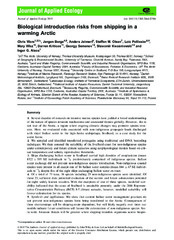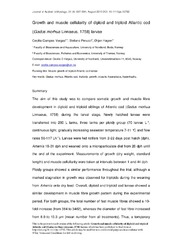Artikler, rapporter og annet (arktisk og marin biologi): Nye registreringer
Viser treff 1361-1380 av 1643
-
Biological introduction risks from shipping in a warming Arctic
(Journal article; Tidsskriftartikkel; Peer reviewed, 2015-12-14)Several decades of research on invasive marine species have yielded a broad understanding of the nature of species invasion mechanisms and associated threats globally. However, this is not true of the Arctic, a region where ongoing climatic changes may promote species invasion. Here, we evaluated risks associated with non-indigenous propagule loads discharged with ships' ballast water to the high-Arctic ... -
The eyes of the deep diving hooded seal (Cystophora cristata) enhance sensitivity to ultraviolet light
(Journal article; Tidsskriftartikkel; Peer reviewed, 2015-05-11)The mammalian visual range is approximately 400–700 nm, although recent evidence suggests varying ultraviolet (UV) extensions in diverse terrestrial species. UV sensitivity may have advantages in the dim, blue light shifted environment experienced by submerged marine mammals. It may also be advantageous when seals are on land as UV is reflected by snow and ice but absorbed by fur, enhancing visual ... -
Extreme Features of the Galdieria sulphuraria Organellar Genomes: A Consequence of Polyextremophily?
(Journal article; Tidsskriftartikkel; Peer reviewed, 2015-12-13)Nuclear genome sequencing from extremophilic eukaryotes has revealed clues about the mechanisms of adaptation to extreme environments, but the functional consequences of extremophily on organellar genomes are unknown. To address this issue, we assembled the mitochondrial and plastid genomes from a polyextremophilic red alga, Galdieria sulphuraria strain 074 W, and performed a comparative genomic ... -
Arctic Ocean outflow shelves in the changing Arctic: A review and perspectives
(Journal article; Tidsskriftartikkel; Peer reviewed, 2015-08-28)Over the past decade or so, international research efforts, many of which were part of the International Polar Year, have accrued our understanding of the Arctic outflow shelves. The Arctic outflow shelves, namely the East Greenland Shelf (EGS) and the Canadian Arctic Archipelago (CAA), serve as conduits through which Arctic sea ice and waters and their properties are exported to the North Atlantic. ... -
Physical constrains and productivity in the future Arctic Ocean
(Journal article; Tidsskriftartikkel; Peer reviewed, 2015-10-20)Today's physical oceanography and primary and secondary production was investigated for the entire Arctic Ocean (AO) with the physical-biologically coupled SINMOD model. To obtain indications on the effect of climate change in the twenty-first century the magnitude of change, and where and when these may take place SINMOD was forced with down-scaled climate trajectories of the International Panel ... -
Shifts in methanogenic community composition and methane fluxes along the degradation of discontinuous permafrost
(Journal article; Tidsskriftartikkel; Peer reviewed, 2015-05-12)The response of methanogens to thawing permafrost is an important factor for the global greenhouse gas budget. We tracked methanogenic community structure, activity, and abundance along the degradation of sub-Arctic palsa peatland permafrost. We observed the development of pronounced methane production, release, and abundance of functional (mcrA) methanogenic gene numbers following the transitions ... -
Macroalgal detritus and food-web subsidies along an Arctic fjord depth-gradient
(Journal article; Tidsskriftartikkel; Peer reviewed, 2015-06-05)Tight coupling between pelagic and benthic communities is accepted as a general principle on Arctic shelves. Whereas this paradigm has been useful for guiding ecological research, it has perhaps led to a disproportionate focus on POM and ice algae as the most likely sources of carbon for the benthic food web. Arctic shelves are complex systems, including banks, fjords, and trough systems up to 350 ... -
Distinct summer and winter bacterial communities in the active layer of Svalbard permafrost revealed by DNA- and RNA-based analyses
(Journal article; Tidsskriftartikkel; Peer reviewed, 2015-04-30)The active layer of soil overlaying permafrost in the Arctic is subjected to dramatic annual changes in temperature and soil chemistry, which likely affect bacterial activity and community structure. We studied seasonal variations in the bacterial community of active layer soil from Svalbard (78°N) by co-extracting DNA and RNA from 12 soil cores collected monthly over a year. PCR amplicons of 16S ... -
Extreme male-skewed sex ratios on spaning grounds for Atlantic cod Gadus morhua with typical coastal cod signatures of the Pan I (pantophysin) locus
(Journal article; Tidsskriftartikkel; Peer reviewed, 2015)Large offshore and small inshore populations of Atlantic cod Gadus morhua L. display differences in migratory patterns and settling regimes, but little is known about possible differences in spawning behaviour. Cod presumably of the Norwegian coastal cod type were therefore sampled during 7 spawning seasons (2002-2013) in Malangen, northern Norway. A spawning site in neighbouring Balsfjord was sampled ... -
Mutual positive effects between shrubs in an arid ecosystem
(Journal article; Tidsskriftartikkel; Peer reviewed, 2015-09-30)One-way facilitation in plants has been found in many harsh environments and their role as structural forces governing species composition in plant communities is now well established. However, reciprocal positive effects benefiting two interacting species have seldom been reported and, in recent reviews, conceptually considered merely as facilitation when in fact there is room for adaptive strategies ... -
Macroalgae contribute to nested mosaics of pH variability in a subarctic fjord
(Journal article; Tidsskriftartikkel; Peer reviewed, 2015-08-19)The Arctic Ocean is considered the most vulnerable ecosystem to ocean acidification, and large-scale assessments of pH and the saturation state for aragonite (Ωarag) have led to the notion that the Arctic Ocean is already close to a corrosive state. In high-latitude coastal waters the regulation of pH and Ωarag is, however, far more complex than offshore because increased biological activity and ... -
Calving rates at tidewater glaciers vary strongly with ocean temperature
(Journal article; Tidsskriftartikkel; Peer reviewed, 2015-10-09)Rates of ice mass loss at the calving margins of tidewater glaciers (frontal ablation rates) are a key uncertainty in sea level rise projections. Measurements are difficult because mass lost is replaced by ice flow at variable rates, and frontal ablation incorporates sub-aerial calving, and submarine melt and calving. Here we derive frontal ablation rates for three dynamically contrasting glaciers ... -
Growth and muscle cellularity of diploid and triploid Atlantic cod (Gadus morhua Linnaeus, 1758) larvae
(Journal article; Tidsskriftartikkel; Peer reviewed, 2015-05-26)The aim of this study was to compare somatic growth and muscle fibre development in diploid and triploid siblings of Atlantic cod (Gadus morhua Linnaeus, 1758) during the larval stage. Newly hatched larvae were transferred into 200-L tanks, three tanks per ploidy group (70 larvae L−1, continuous light, gradually increasing seawater temperature 7–11°C and flow rates 50–117 L h−1). Larvae were fed ... -
Responses in Arctic marine carbon cycle processes: Conceptual scenarios and implications for ecosystem function
(Journal article; Tidsskriftartikkel; Peer reviewed, 2015-04-15)The Arctic Ocean is one of the fastest changing oceans, plays an important role in global carbon cycling and yet is a particularly challenging ocean to study. Hence, observations tend to be relatively sparse in both space and time. How the Arctic functions, geophysically, but also ecologically, can have significant consequences for the internal cycling of carbon, and subsequently influence carbon ... -
Benthic algal vegetation in Isfjorden, Svalbard
(Journal article; Tidsskriftartikkel; Peer reviewed, 2015-08-11)Benthic algal vegetation was investigated at 10 sites in Isfjorden, Svalbard. Five sites were visited during summer 2010 and five during summer 2012. Both the littoral and sublittoral vegetation were sampled, the littoral by hand-picking and use of a throwable rake and the sublittoral using a triangular dredge. A total of 88 different taxa were registered, comprising 17 Chlorophyta, 40 Ochrophyta, 30 ... -
Definition of sampling units begets conclusions in ecology: The case of habitats for plant communities
(Journal article; Tidsskriftartikkel; Peer reviewed, 2015-03-05)In ecology, expert knowledge on habitat characteristics is often used to define sampling units such as study sites. Ecologists are especially prone to such approaches when prior sampling frames are not accessible. Here we ask to what extent can different approaches to the definition of sampling units influence the conclusions that are drawn from an ecological study? We do this by comparing a ... -
Rough-legged buzzards, arctic foxes and red foxes in a tundra ecosystem without rodents
(Journal article; Tidsskriftartikkel; Peer reviewed, 2015-02-18)Small rodents with multi-annual population cycles strongly influence the dynamics of food webs, and in particular predator-prey interactions, across most of the tundra biome. Rodents are however absent from some arctic islands, and studies on performance of arctic predators under such circumstances may be very instructive since rodent cycles have been predicted to collapse in a warming Arctic. ... -
Predator–rodent–plant interactions along a coast–inland gradient in Fennoscandian tundra
(Journal article; Tidsskriftartikkel; Peer reviewed, 2015-11-09)Spatial variation in the strength of trophic cascades in arctic tundra has been related to flows of subsidies across ecosystem boundaries. Here, we ask whether the input of marine subsidies in tundra systems would cause spatial variation in the strength of rodent–plant interactions between coastal areas, where predators have access to marine-derived resources, and non-subsidized inland areas of ... -
Seasonal Differences in Relative Gene Expression of Putative Central Appetite Regulators in Arctic Charr (Salvelinus alpinus) Do Not Reflect Its Annual Feeding Cycle
(Journal article; Tidsskriftartikkel; Peer reviewed, 2015-09-30)The highly seasonal anadromous Arctic charr (Salvelinus alpinus) was used to investigate the possible involvement of altered gene expression of brain neuropeptides in seasonal appetite regulation. Pro-opiomelanocortin (POMCA1, POMCA2), Cocaine and amphetamine regulated transcript (CART), Agouti related Peptide (AgRP), Neuropeptide Y (NPY) and Melanocortin Receptor 4 (MC4-R) genes were examined. The ... -
The relationship between patterns of benthic fauna and zooplankton in the Chukchi Sea and physical forcing
(Journal article; Tidsskriftartikkel; Peer reviewed, 2015-09)Using data from a number of summer surveys of the Chukchi Sea over the past decade, we investigate aspects in which the benthic fauna, sediment structure, and zooplankton there are related to circulation patterns and shelf hydrographic conditions. A flow speed map is constructed that reveals the major pathways on the shelf. Regions of enhanced flow speed are dictated by lateral constrictions—i ...


 English
English norsk
norsk


















